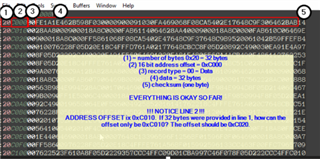Other Parts Discussed in Thread: UNIFLASH
Hi All,
i am using flashing tool to load application hex.
Tool is not sending all data . because of address offset issue.
Address offset in hex is shift by 0x10 because i selected ROM width 16 in CCS hex utility. hence tool is sending half data only ( 16 bytes only ).
Flashing tool require memory offset 0x20 to send all 32 bytes data. is there any option in CCS hex utility to make address offset 0x20 ?
if i keep room width blank (0) in hex utility then hex address offset is 0x20 but this hex will not work properly with uniflash tool so it is incorrect hex.
Flashing tool company is telling their script require 0x20 address offset which is standard format of hex.
It is very high priority topic please help me to resolve this issue.
please check blow snap for more understanding.


